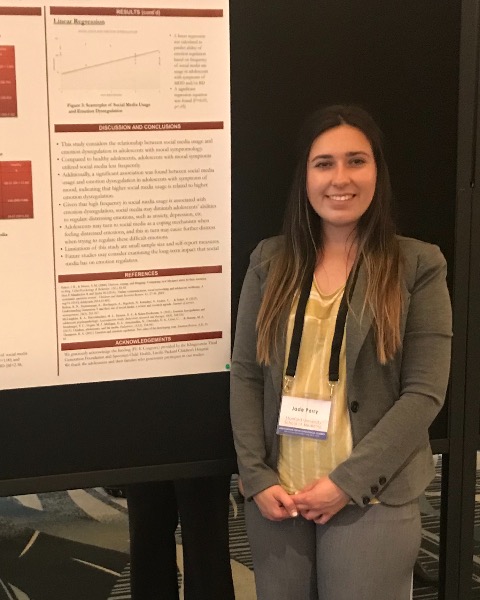Child / Adolescent - Depression
Resiliency in the Face of Cyber Victimization: Family, but not Peer, Support Emerges as a Protective Factor
(PS3-B32) Resiliency in the Face of Cyber Victimization: Family, but Not Peer, Support Emerges as a Protective Factor
- CK
Caroline Kelberman, B.A.
Clinical Psychology Graduate Student
University of Maine
Bangor, Maine 
Jade S. Perry, M.A.
Graduate Student
University of Maine
Morgan Hill, California
Michelle L. Buffie, M.A.
Clinical Psychology Graduate Student
University of Maine
Portland, Oregon- DN
Douglas W. Nangle, Ph.D.
Professor
University of Maine
Orono, Maine - ES
Eleanor Schuttenberg, B.S.
Clinical Psychology Graduate Student
University of Maine
Bangor, Maine
Co-Author(s)
Author(s)
Cyber victimization (CV), or exposure to behaviors that are perpetrated online or via technology, is prevalent among adolescents (Zhu et al., 2021). Adding to this concern is the continued COVID-19 pandemic, which has resulted in adolescents spending more time online, and thereby increasing their risk of victimization (Mkhize & Gopal, 2021). World-wide, prevalence rates suggest that up to 40% of adolescents have experienced CV (Zhu et al., 2021), and such exposure has been linked to increased risk of mental health difficulties, including anxiety, substance use, and depression (Díaz & Fite, 2019; Fahy et al., 2016; Rose & Tynes, 2015; Tran et al., 2021). Perceived social support is one mechanism demonstrated to be protective against depression across the lifespan (Gariépy et al., 2016). Whereas some research has suggested that social support from peers-not family- is an important protective factor against mental health difficulties in the face of victimization, other studies have indicated that familial-not peer- support better protects adolescents from developing depression after exposure to cyber victimization (Hellfeldt et al., 2020; Ringdal et al., 2021).
The present study investigated the relative influences of three major types of perceived social support (friends, significant others, and family) on the established CV-depression relationship. Adolescents (N = 119; 46 male, 65 female, 1 transgender, 4 non-binary, 2 questioning, and 1 “other”) aged 13-17 completed the Center for Epidemiological Studies Depression Scale, the Cyber Peer Experiences Questionnaire-Adolescent, and the Multidimensional Scale of Perceived Social Support.
Correlational analyses confirmed that lifetime cyber victimization was positively related to depression symptoms (p < .001). Depression was significantly correlated with all three subscales of perceived social support (friends, significant others, and family p < .05). However, CV was significantly correlated with only perceived social support of family (p < .001). A mediation analysis was performed using PROCESS to examine the effect of perceived social support of family on the relationship between lifetime cyber victimization and depression. The full model accounted for 27.52% of the variance (R2 = .2752, F(2, 116) = 22.03, p < .001). Higher levels of lifetime cyber victimization predicted lower levels of perceived social support of family and more depression, while lower levels of perceived social support of family predicted more depression. Perceived social support of family had a significant indirect effect on the relationship between lifetime cyber victimization and depression (b= 2.44, CI .98, 4.08).
These findings indicate that perceived social support of family has a significant indirect effect on the relationship between CV and depression. Perceived social support from families appears to function as a protective factor for victimized adolescents, perhaps by providing support to adolescents coping with negative emotions from victimization, or by intervening to stop the victimization. Future longitudinal research is needed to investigate the impact that increased perceived social support of family has on depressive symptoms during adolescence.

